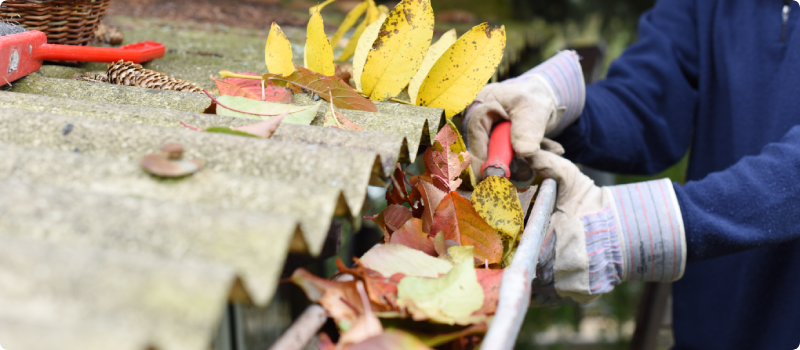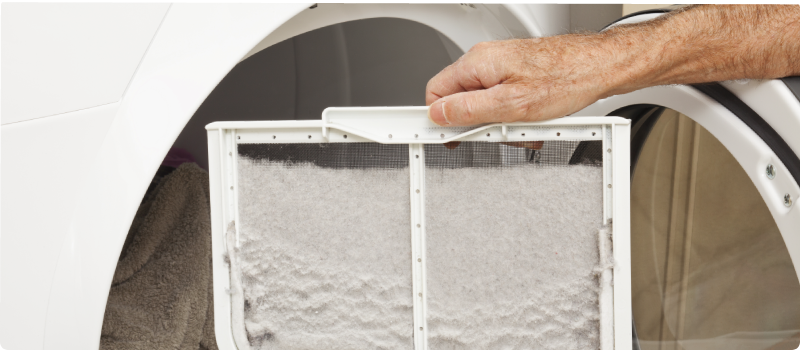
Home maintenance checklist: the ultimate plan
Updated February 7, 2024 . AmFam Team
Just like cars, your home needs special care to avoid breakdowns and costly repairs throughout the year. Without regular maintenance, you’ll likely stumble upon various frustrating, expensive surprises in your home that’ll cost you valuable time and drain your bank account. But with regular property preventive maintenance, you’ll hone your handyperson skills and keep your home in tip-top shape.
The key is making a scheduled checklist that you can follow as the seasons change. Here’s what we recommend:

Monthly home maintenance checklist
Some maintenance items will require more attention than others. These tend to be things in your home that help keep everyone safe, so be sure to check in regularly and make sure they’re working. Here’s what you should do each month:
Test your alarms and detectors
Your smoke alarms and carbon monoxide detectors are crucial to the safety of your family. Check them once a month and be sure to have replacement batteries on hand. Fire extinguishers are very important to your family’s safety as well. Inspect them regularly to make sure they’re working.
Want to make this step even easier? Invest in smart smoke and carbon monoxide detectors. You’ll get reminders when they need attention and notifications of dangerous fumes in your home. Plus, you could qualify for a discount on your home insurance!
Check and replace your filters
Your furnace, oven and vent filters should be checked every month to make sure debris isn’t preventing them from doing their job. Stock up on replacement filters for each appliance so you can swap in a new one at a moment’s notice.
Check pipes for clogs
Your kitchen sink, bathroom drains and garbage disposal might not be running efficiently if there’s even a minor blockage in a connected pipe. Check to see if they’re draining slowly by running hot water for about 30 seconds, then use a natural drain cleaning product to knock away the grime.
Clean your air vents
Air vents can build up a lot of dust. Clear them up by turning off your HVAC system, brushing the walls to loosen any grime and putting your vacuum to work.
Check your sump pump
When it comes to leaky basements, your sump pump can make all the difference. This helpful piece of hardware may be the only defense you have against a full-fledged flood. Prevent a worst-case scenario by testing your sump pump on schedule.
Look for leaks or cracks in your faucets
A leaky faucet can waste water and boost your monthly utility bill without you noticing. Check the spout, the base and under your sink to see if water is leaking or moisture is outside the pipes.
While you're at it, inspect grout and caulk to see if any touch-up is needed to prevent seeping water damage.

Biannual home maintenance checklist
Not every part of your home needs a monthly checkup. Perform these home improvement tasks just twice a year to keep your home healthy:
Inspect your attic and basement
Look for any cracks in the walls, deteriorating insulation, leaks or pests that could be causing harm to your home’s structure.
Clear your gutters and downspouts
A clogged gutter or downspout can lead to water backup, pooling moisture and the deterioration of your home’s siding and structure. Clean your gutters thoroughly with proper safety equipment to keep them functional.
Clean your refrigerator coils
Vacuum the coils on the back and bottom of your refrigerator to remove any buildup. This will allow it to operate more efficiently, leading to savings on your electric bill.

Annual home maintenance checklist
Small problems in your home can turn into major ones if you wait too long to address them. Complete these home maintenance tasks once per year to save money on down-the-line home repairs.
Clean your dryer vent
Lint that builds up in your dryer not only decreases performance but can actually be a fire hazard. Keep a brush handy and make cleaning your lint trap and dryer vent an annual routine.
Flush your water heater
Emptying your tank and filling it with fresh water is a great way to figure out your water heater’s health status. Maintaining your water heater might sound like an intimidating task, but by flushing it once a year, you can make that maintenance stress-free.
Inspect for termites
Checking your home for signs of wood damage and termites can help you avoid a major infestation. If you’re not quite sure how to check for termites, call in a professional! Ask about other preventative measures you can take to keep them out.
Trim tree branches
Cutting branches close to your home's roof can help you avoid major storm damage the next time heavy rain and strong winds roll through.

Spring home maintenance checklist
As seasons change, so should the focus of your home maintenance efforts. Since not all seasons are created equal, there are some key maintenance items you need to focus on during different times of the year.
So, as the cold weather begins to dissipate and flowers begin to flourish, your home maintenance list will begin anew too. Protecting your home from wintry conditions segues to ensuring your home is ready for warmer weather. If you’ve noticed your trees beginning to bud, then it’s time to start your spring-cleaning initiatives with these important upkeep tasks.
Check and clean your window screens
Winter weather can be harsh on your screens. Check them for rips, cracks or other damage and install new ones if necessary.
Reseal fences and decks
Help your home’s woodwork defend itself against the spring rain and extra moisture by resealing and finishing.
Check your driveway and walkways for cracks
Spring is considered pothole season, as the winter’s snow and ice can be particularly damaging to roadways. The same goes for your driveway and walkways — check them for cracks and patch them as soon as possible to prevent further damage.
Inspect your air conditioning unit
Checking your AC unit long before summer arrives gives you plenty of time to have it fixed should there be any problems. Don’t be afraid to call a professional!
Check your paint and siding
Freshening up your home’s paint job or replacing damaged siding after the winter can do wonders for its curb appeal. Plus, your siding is a crucial part of your home’s defenses against moisture and other damage, so keeping it intact is a must.

Summer home maintenance checklist
Summer is the perfect season to unwind. But before you hop into your hammock, there are some routine home maintenance items that need your attention.
Once you’ve worked your way down this checklist, then it’s time to kick your summer relaxation time into full gear.
Clean your air conditioner filter
You had your system tuned up in the spring, so it’d be ready to go for the summer. But, to keep things running smoothly, you should still check and clean your filter at least twice a month.
Prepare your grill
Cleaning your grates, airing it out and making sure it’s working properly will help you avoid disappointment when you fire it up for the first hot dogs of the summer.
Control bugs and mosquitoes
Removing stagnant, pooled water and using natural solutions to keep bugs and mosquitoes from bothering you while you're outside will make for a much more enjoyable summer for your family.
Check and replace storm windows
Your storm windows help insulate your home — keeping it cool in summer and warm in winter. Check your storm windows for cracks or damage in case they need to be replaced.

Fall home maintenance checklist
Depending on what part of the nation you live in, you may not need to pack up that hammock as Autumn rolls in. But once the leaves begin to fall, and the air begins to cool, it’s time to begin preparing for colder weather. Here are some tips to help you stay ahead of the curve so you can be worry-free as fall’s cooler climate comes to town.
Schedule heating system maintenance
Unless you’re an HVAC professional, you’re better off leaving this one to the techs. Get ahead of the curve and schedule a maintenance visit.
Rake leaves
Unraked leaves and debris can keep the sunlight from reaching your grass, inhibiting growth for next spring, and providing a fertile ground for harmful mold to grow.
Seal cracks in your windows and doors
Keep the cold air out when fall and winter temperatures drop. Check the caulk around your windows and invest in door stoppers to keep your home warm and toasty.
Check your pipes’ insulation
A frozen pipe can lead to a disaster if it’s not cared for immediately. Prevent your pipes from freezing in the first place by insulating them and keeping your home’s temperatures up.
Drain and turn off sprinklers
If your home’s sprinklers freeze, they’re likely to break. Save yourself a trip to the hardware store by draining and storing them in a warmer area for the colder months.

Winter home maintenance checklist
Winterizing your home ahead of time is essential but responding to issues quickly is even more important. Winter can really wreak havoc on your home, but your winterhome maintenance can prevent issues before they become a serious (and expensive) problem.
Here are some tips to keep your winter stress-free:
Inspect your pipes
Keeping an eye on the pipes you insulated in the fall will help you avoid a cold, wet basement disaster. If you think your pipes are frozen, turn off your water and carefully thaw them to prevent them from bursting.
Prepare for snow
Get your snow blower, shovels and sidewalk salt out and have them ready to go when the first snowstorm hits.
Prevent ice dams and prep your roof
Heavy snowfall can cause damage to your roof. Take proactive steps to prevent your roof from collapsing due to snow by getting it inspected and ensuring there’s proper ventilation installed. This can help prevent ice dams from forming.
Protect your outdoor furniture
Moving your patio furniture and other outdoor leisure items inside will protect them from the wind, snow and ice that winter brings.
Year-round protection built for you
With these checklists, you now have the know-how to keep your home safe and in great condition any time of the year. But if the unexpected does happen, you’ll need to make sure your home is protected. Get in touch with your American Family Insurance agent to make sure you’ve got even more protection with a customizable homeowners insurance policy. Your agent can help make sure your coverage limits, deductible and add-on coverages are giving you the peace of mind you deserve.
Looking for even more home maintenance tips? Our home maintenance hub has all the resources you’ll need to keep your home in great shape throughout the year.
This article is for informational purposes only and based on information that is widely available. We do not make any guarantees or promise any results based on this information.

